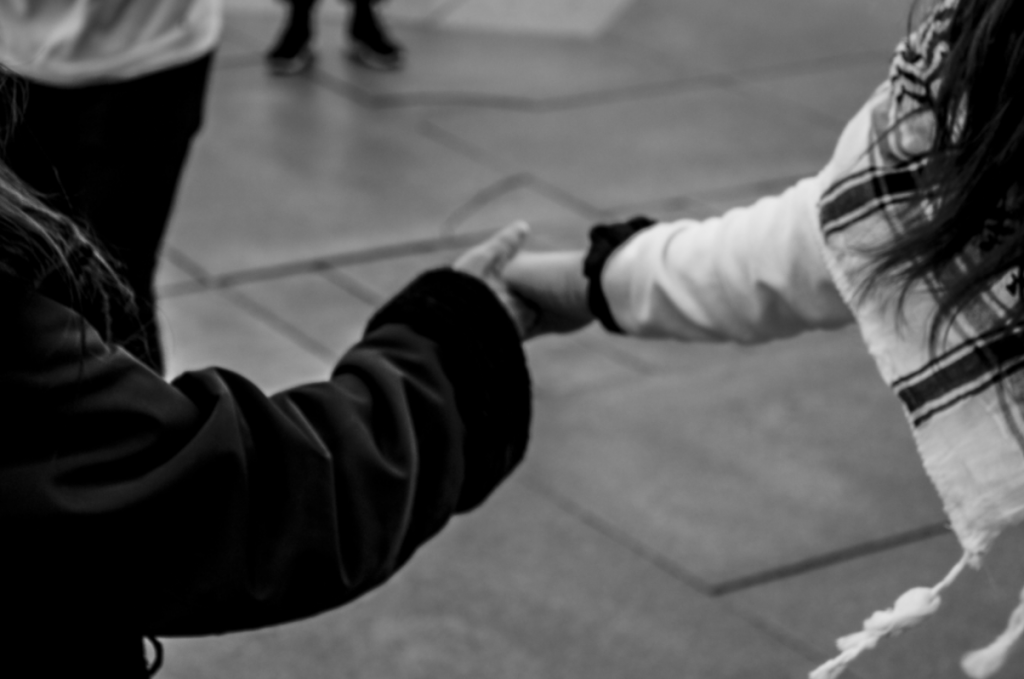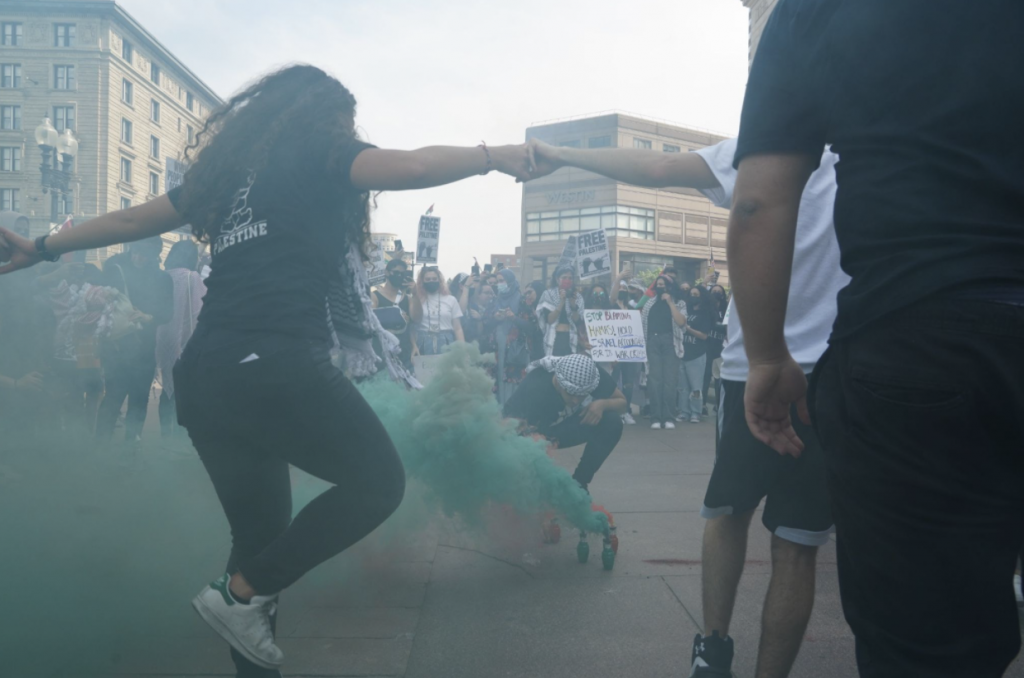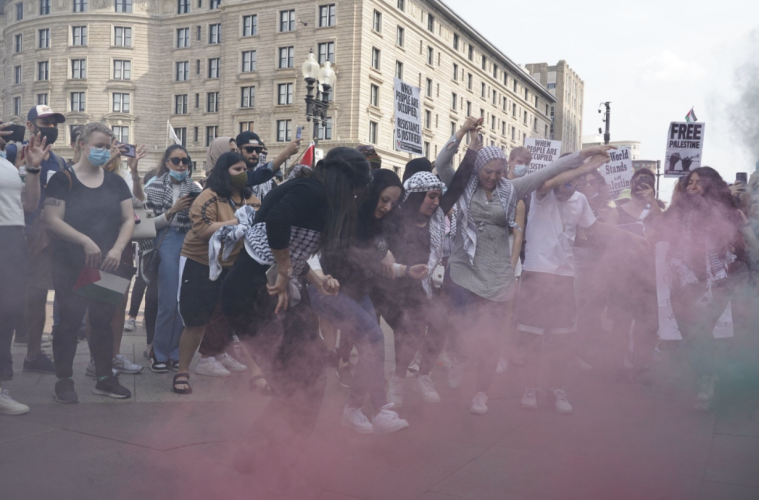Article by: Bintfalisteen & Salma Shawa
Featured Photograph by: Omar Taweh, in Boston, MA*
This article is part of the “Ya Leil Ya Eyein” issue
As all righteous and justice-seeking people move onward with life and continue to push for the liberation of all oppressed peoples of the world, the Palestinian community is left to reflect on the impact of the last three months, but particularly the month of May.
For Palestinians across the world, May 2021 was a month characterized by constant displays of solidarity and engagement through social media, on the ground action, organizing, and community building. The overwhelming power of social media outlets in helping organizers and activists send a message to the world resulted in ebbs and flows of adrenaline rushes, anxiety, and inevitably burnout for many.
However, the month of May 2021 also brought the Palestinian community from around the world closer than ever. We heard the calls and demands of our people from across arbitrary colonial borders, uniting under the banner of the “Unity Intifada” and guided by words of the “The Dignity and Hope Manifesto”.
“In these days, we write a new chapter, a chapter of a united Intifada that seeks our one and only goal: reuniting Palestinian society in all of its different parts; reuniting our political will, and our means of struggle to confront Zionism throughout Palestine.” – “The Dignity and Hope Manifesto”
Truly, May prompted a united front of Palestinians from all over the world engaging in community-based organizing rooted in the demands sent from Sheikh Jarrah, Gaza, the West Bank, and 1948 Occupied Palestine. Each community, whether in the Western diaspora or on the ground in Jerusalem and Haifa worked (and continue to work) within their own community contexts and struggles.
It is not out of the ordinary to see Palestinian women, femme, and Queer organizers leading the path for action on Palestine. Palestinian women, femme, and Queer organizers were at the frontlines of this work, from Muna and Mohammed El-Kurd, Mona Beniamyn, Nerdeen Kiswani and those who worked tirelessly to educate and use their social media platforms, including @QueerPalestinian and @enbyshami @anatinternational, and @bintfalisteen on Instagram. These individuals played a critical role in the execution of on the ground organizing activities and information distribution across social media platforms.
The impetus behind organizing on the ground both in Palestine and within the Palestinian diaspora across the world is and has always been a preservation of Palestinian identity and culture in the face of Israel’s system of ethnic cleansing. One of the many forms of cultural resistance Palestinians engage in is the traditional Palestinian folklore dance of dabke.
May 2021 revealed a new community discourse on the role of dabke during protests organized in diaspora communities, primarily those taking place in the West (USA,Canada, Europe, and Australia). The conversation was sparked by TikTok and Twitter arguments as well as in person spouts on the morality of dancing dabke while literal bombs were being dropped on the people of Gaza.
Of course we cannot deny that dabke is a form of cultural resistance, but the question remains whether or not there is a time and a place for it to take place, especially whether it is morally acceptable to engage in such a celebratory action far away from the reality of living under siege, occupation, and live bombing experienced by Gaza’s residents.
The following is a reflection-based conversation between Bintfalisteen, a U.S. diaspora-based organizer/activist and Salma Shawa, an activist and entrepreneur from Gaza, and based in the U.S.
***
Bintfalisteen: What is the purpose/role of dabke in your opinion?
Salma Shawa: If one were to understand the advantages, as well as limitations of using something,whatever that thing might be, it is critical that one assess the purpose of the object in question. So, if we reflect on dabke’s purpose and role in Palestinian culture historically and currently, it is clear that dabke has been (and is) pre-dominantly used during celebrations, weddings, any other moments of joy. No one dances during funerals. The massacres that we saw in Gaza, with countless martyrs, is a mass funeral — so how could we justify dancing during protests occurring at the very moment that people were being killed?
And speaking of purpose, not all dances serve the same purpose. For example, if we look at the Haka dance, native to the Māori peoples of New Zealand, Haka was used during war-time as a “cry” and in funerals to express sadness and rage. The dance is also currently used in moments of pride, as is the case during New Zealand’s rugby games. The point is, a dance like Haka has multiple purposes and could be used during moments of rage/sadness (for example, when there was a terrorist attack on a mosque in New Zealand), because it is performed through facial expressions and vocalizations, making it way more appropriate to use during times of grief than blasting music during a protest taking place during aggression and violence.
Bintfalisteen: Do you think it is necessary to deploy dabke as a tool of cultural resistance during times of crisis?
Salma Shawa: We saw many different displays of solidarity during the protests, and dancing was one of them. Although dabke was definitely used with benign intentions and from a place of good-heartedness, its role during periods of pronounced violence is questionable because it can aggravate the mental and emotional wellbeing of a segment of protestors that have family/friends experiencing the onslaught on the ground.
Personally, this was the case with me when the attacks were occuring in Gaza at a massive scale; I could not stand anyone dancing or playing loud music when all that I could think of was my parents back home. It 100% alienated me during the protests, and had me subconsciously build resentment towards anyone initiating dance, no matter how hard I tried to control those feelings of distress.
I think in the context of Palestine, dancing during periods of heightened violence does more harm than good, as it impedes us from uniting to send one coherent message, and instead makes it so that some people feel betrayed that their counterparts are dancing and singing when Palestinians are being murdered on the ground. If unity is our goal, then being sensitive to the harsh reality on the ground is integral to reaching that goal. And sadly, the reality on the ground during May did not involve dabke or joy– it was purely a series of massacre after massacre.

Photograph by Bintfalisteen in Boston,MA*
Salma Shawa: Do you see/understand dabke to be interpreted differently across the global and widespread Palestinian community?
Bintfalisteen: While I do think dabke is something that we as a community collectively identify with (as well as across the Levant region), I do strongly believe that there are simultaneous parallels and differences between how dabke is used by Palestinians living inside historical Palestine and those living across the diaspora.
For example, a diaspora organized protest by Palestinians in America is almost entirely incomplete without dancing dabke at the end of an action. It’s become a form of unification among the community and a means by which the Palestinian-American community reinforces their heritage in the streets of New York or Chicago for example. In these instances I see it as a form of exercising our collective self determination within the confines of a country that is at the crux of our people’s daily suffering.
On the other hand, from what I’ve witnessed and heard from people on the ground in Palestine is that during action and protests, dabke is not necessarily used as often, as there is little time for dancing dabke while under the bullets and bombs of the oppressor.
However, when Palestinians of the diaspora hear this they will often counter this point with the viral video of Palestinians in Gaza dancing dabke during the Great March of Return back in 2018. Personally, I’m not sure if this is justification enough, as circumstances are always totally different and we cannot compare the events of the Great March of Return to those of May 2021 and previous aggressions on Gaza.

Photograph by Omar Taweh in Boston, MA*
What is a good example of “protest etiquette”, from your perspective?
Salma Shawa: Good question–I actually had posted a short statement during the attacks on Gaza regarding that topic, and my take is neatly summarized in the below infographic:

Graphic by Ayah Ghanameh. Written by Salma Shawa from @Anat.International*
Bintfalisteen: I agree with Salma’s statement wholeheartedly. I don’t think we can have dabke while members of our community are not in a celebratory state of mind and bombs are being dropped overhead the homes of their loved ones. As an organizer, I take this statement very seriously and hope that community members understand the context and validity of this opinion. But of course, at the end of the day people must also understand how terribly hard it is to control crowds and their actions. Some choose to respect these statements while others ignore and dabke regardless during protests.

